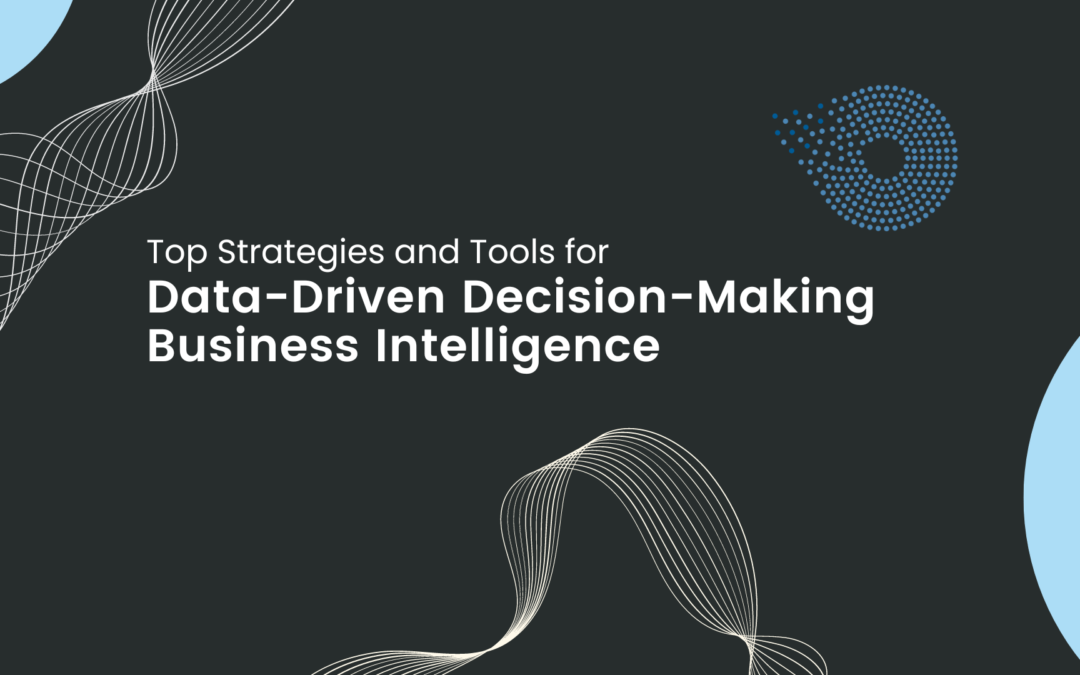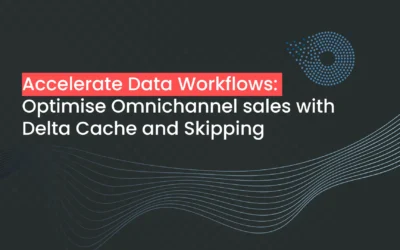[pac_divi_table_of_contents included_headings="on|on|on|off|off|off" minimum_number_of_headings="6" scroll_speed="8500ms" level_markers_1="decimal" level_markers_3="none" title_container_bg_color="#004274" _builder_version="4.22.2" _module_preset="default"...

Top Strategies and Tools for Data-Driven Decision-Making Business Intelligence
In the modern business climate, data-driven decision-making is taking on an increasingly significant role. Recent data show the significant benefits of using this method. Forbes found that organizations that use data-driven insights boost productivity and profits by 5-6% on average.
In addition, research conducted that companies that base their decisions on data have a return on investment (ROI) that is 30 % higher than that of their competitors. These astounding numbers show what data-driven decision-making is and how much data-driven decision-making can transform the success of a business.
In this post, we’ll go into the best decision-making strategies and resources for maximizing a company’s data resources so that it may make accurate decisions and do incredible things with its BI efforts.
What is data-driven decision-making?
“Data-driven decision-making” refers to a methodology in which relevant and trustworthy data is used to inform and maintain company decision-making.
Insights, trends, and decisions come from data analysis and interpretation, which drives company plans and actions. Decisions are not based on assumption or personal preference under this approach; actual data confirm them.
Why data-driven decision-making matters
In today’s business world, making data-based decisions is highly important. Leveraging data for decision-making is not advantageous in today’s data-driven environment; it’s necessary for long-term development and success.
- Data-driven insights.
- Reduces gut-based judgment risks.
- Identifies trends and patterns for commercial decision-making.
- Helps decision-making.
- Finds novel opportunities and provides companies with an advantage.
- Improves client awareness and customization.
- Enables proactive decision-making.
- Allows businesses to evaluate decisions.
- Supports making decisions based on facts for better results.
- Improves organizational productivity.
Quality Matters: Tackling Problems with Data Management and Quality
Businesses need help to gain insights from their massive data sets. Due to data abundance, fragmentation, quality issues, and analytical bottlenecks, organizations need help to gain insights that drive decision-making and business success.
Use intelligent technologies and effective data management and analysis to overcome such problems. If a company overcomes the dilemma of too much data and not enough insights, it may unlock its data’s full potential and make data-driven choices.
- Companies are generating massive volumes of data, including information from customers, transactions, sensors, and social media.
- Problems arise when attempting to make insights from the massive amounts of data available.
- It is difficult to gain a bird’s-eye view of data due to its fragmentation and silos inside many systems and departments.
- Poor data quality and dependability result from poor data governance and management policies.
- Needs to improve in gaining valuable insights due to ineffective data processing and analysis methods.
- Insufficient personnel and time to manage and analyze extensive data collection.
- Lack of capacity to identify trends, correlations, and other meaningful data patterns that might benefit decision-making.
- Challenges in turning raw data into insights that can be used to make business decisions and support growth.
- The possibility that judgments may be made with insufficient details, leading to undesirable results.
- Methods and resources are required to efficiently process, analyze, and display data to reach valuable insights.
Decision-Making Strategies Based On Data
Data-driven decision-making in business intelligence helps companies to use data to make successful decisions. These decision-making strategies can help businesses improve data-driven by setting clear goals and using modern analytics data-driven marketing tools.
1. Set Goals and KPIs
- Spell out the long-term aims that support the company’s overall strategy.
- Determine the metrics that will serve as checkpoints along the way to success.
- Goals and key performance indicators should be SMART, specific, measurable, attainable, relevant, and punctual.
2. Get All the Important Information Together
- Determine the information requirements for making choices consistent with the goals.
- Set up procedures and guidelines for data collecting to ensure you have all the information you need.
- You should use decision-making strategies to ensure your data is correct, consistent, and of high quality.
3. Examine Information for Valuable Insights
- Methods of data analysis include descriptive, diagnostic, predictive, and prescriptive analytics should be used.
- Use data visualization tools to successfully express your findings and promote awareness.
- Find the trends and relationships in the data to reach conclusions and provide suggestions.
4. Promote an Environment Where Decisions Are Based on Facts and Data
- Train staff on data-driven decision-making.
- Spread the idea that choices should be based on evidence rather than gut feelings or discrimination throughout the company.
- Integrate data analysis into decision-making through the implementation of procedures and workflows.
5. Keep Information Safe, Reliable, and Accurate
- Put in place mechanisms for data quality control to ensure that your data remains accurate and undamaged.
- It’s essential to regularly check and evaluate data sources to make sure they’re accurate.
- Protect sensitive data with high-quality data-driven solutions while meeting regulatory requirements.
- By implementing these methods, businesses may use the potential of data-driven decision-making to improve operational efficiency, increase profitability, and expand market share.
Many data-driven decision-making examples show how data-driven decision-making may be utilized across various disciplines to increase efficiency, improve results, and gain an edge over competitors.
By putting the power of data to work for them, companies may get access to valuable insights and make well-informed decisions, which lead to improved business outcomes.
10 Data-driven decision-making examples are below.
- E-commerce
- Energy Management
- Manufacturing
- Travel and Tourism
- Education
- Retail
- Healthcare
- Financial Services
- Marketing
- Supply Chain
1. E-commerce
Online retailers enhance website performance through data-driven decisions. They evaluate website traffic, user behavior, and conversion rates to optimize page load speeds, checkout process efficiency, and user experience. This boosts client happiness, revenue, and growth.
2. Energy Management
Data-driven decision-making optimizes energy use and lowers costs for energy companies. Energy-saving options, optimized consumption patterns, and energy-efficient technology are identified by analyzing real-time energy data, weather trends, and equipment performance. This reduces energy waste, operational costs, and sustainability.
3. Manufacturing
Data-driven decision-making improves operational efficiency and quality control. They examine production data, equipment performance, and defect rates to find bottlenecks, optimize production schedules, and enhance quality. This streamlines manufacturing reduces waste, and ensures high-quality goods.
4. Travel & tourism
Data-driven decision-making personalizes client travel experiences. They create trip packages based on customer preferences, travel trends, and feedback data. Satisfaction and loyalty increase.
5. Education
Data-driven decision-making improves student achievement in schools. They identify at-risk kids, administer targeted interventions, and assess student progress by analyzing academic, attendance, and demographic data. This aids program customization, resource allocation, and student achievement.
6. Retail
Data-driven inventory management optimizes retail. They estimate demand, optimize stock levels, and avoid stockouts by analyzing sales, customer demand, and supply chain data. This improves customer happiness, lowers expenses, and maximizes profits.
7. Healthcare
Data-driven decision-making improves patient care. They use patient health information, medical research, and treatment outcomes to uncover best practices, enhance diagnosis, and tailor treatment programs. This improves patient care and quality.
8. Financial Services
Financial institutions use data to analyze creditworthiness and risk. They use credit scores, financial data, and market trends to assess lending, investing, and risk. This reduces chances, improves financial performance, and ensures compliance.
9. Marketing
Data-driven marketing agencies optimize campaigns. Target audiences, messages, and marketing budgets are identified by analyzing consumer behavior data, market research, and campaign performance indicators. This boosts campaign ROI, consumer engagement, and business growth.
10. Logistics
Data-driven decision-making optimizes supply chain operations. They optimize warehouse sites, delivery routes, and supply chain efficiency by analyzing inventory, transportation, and demand data. This reduces prices, lead times, and supply chain performance.
Tools for Data-Driven Decision-Making Business Intelligence
Using Data-Driven Decision Making tools, businesses can speed up their data-driven decision-making processes, get more in-depth insights, and make better-informed decisions that boost growth, improve operational efficiency, and better customer experiences.
By leveraging data analysis and advanced algorithms, these tools assist in generating accurate forecasts and guiding strategic decision-making processes. With their ability to uncover patterns and trends, decision-making tools enable businesses to stay ahead of the competition and drive success in a rapidly changing market.
The unique demands and goals of the company, as well as the complexity of the data and analytics requirements, are all factors that should be considered when selecting the appropriate technologies or using data-driven marketing tools.
1. Business Intelligence Platforms
Thanks to software applications, Businesses can now collect, analyze, and display data from a broad range of sources. This provides a way for businesses to make informed decisions based on real-time information, which produces a win-win situation for everyone involved.
2. Data Visualization Tools
Many data-driven marketing tools assist in turning complex data sets into visually attractive charts, graphs, and interactive dashboards, which makes it simpler to analyze and communicate results. These tools may be found on GitHub.
3. Software for Statistical Analysis
Programs such as SPSS SAS give sophisticated capabilities for statistical analysis. These capabilities allow companies to discover hidden patterns, trends, and correlations within their data.
4. Data Mining Tools
These kinds of tools assist businesses in collecting valuable information and patterns from large datasets, which may be time-consuming to do manually. Because of this, companies can base their judgments and estimations on the data rather than on their emotional responses alone.
5. Tools for Predictive Analytics
Organizations can employ machine learning algorithms and predictive models with the help of tools such as IBM Watson Analytics, Microsoft Azure ML, and Google Cloud AutoML. Decision-making tools empower organizations to gain valuable insights, predict trends, and make informed choices.
6. Tools for Data Warehousing
Platforms like Amazon Redshift, Google BigQuery, and Snowflake offer scalable and efficient storage solutions for significant data. These data-driven solutions facilitate data-driven decision-making tools by assuring instant access to information important to the choice.
7. Machine Learning Platforms
Machine learning platforms provide organizations with the decision-making tools and frameworks to design and implement machine learning models. This creates a way for data-driven decision-making through the use of predictive analytics.
8. Cooperation and Communication Tools
Tools like Google Docs, Microsoft Teams, and Slack encourage unity among team members by allowing them to exchange ideas, discuss findings, and mutually make decisions based on available information.
9. Information Security Tools
These types of decision-making tools, such as Collibra, Informatica, and Talend, are examples of data governance and information security tools. These decision-making tools aid in controlling data quality, guaranteeing data integrity, and implementing security measures to secure sensitive information.
Wrapping It Up
Using data analytics to get business insights and make decisions is a growing industry, as evidenced by several studies. By 2023, more than a third of major companies will employ analysts engaged in decision intelligence. Because of its focus on delivering valuable, explorable data insights, business intelligence solutions are an integral part of business analytics.
Recent Post
Accelerate Data Workflows: Optimize Omnichannel sales with Delta Cache and Skipping
What is Ad Hoc Analysis and Reporting?
[pac_divi_table_of_contents included_headings="on|on|on|off|off|off" minimum_number_of_headings="6" scroll_speed="8500ms" level_markers_1="decimal" level_markers_3="none" title_container_bg_color="#004274" _builder_version="4.22.2" _module_preset="default"...
Top Benefits of Data Governance for Your Organization
[pac_divi_table_of_contents included_headings="on|on|on|off|off|off" minimum_number_of_headings="6" scroll_speed="8500ms" level_markers_1="decimal" level_markers_3="none" title_container_bg_color="#004274" admin_label="Table Of Contents Maker"...




